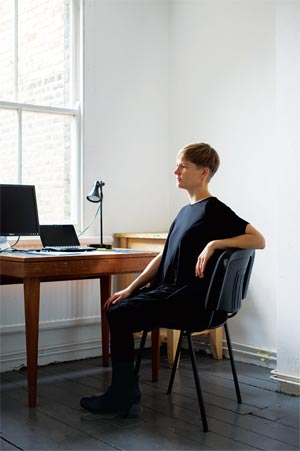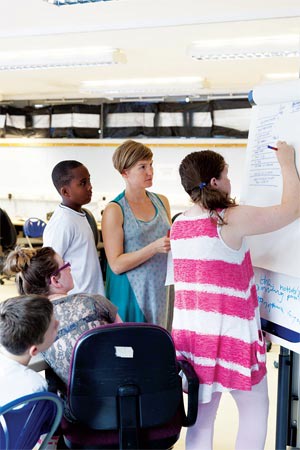Artist Pilvi Takala and her Emdash project

Simply sign up to the Life & Arts myFT Digest -- delivered directly to your inbox.
Art fairs tend to be adult arenas, notwithstanding the occasional works of childlike genius. But the Finnish artist Pilvi Takala is lowering the age bar at Frieze in London this year. She has taken the £10,000 awarded to her in June by the Emdash Foundation (a private foundation that supports emerging artists) to create a new piece of work to be launched at the fair, and passed most of it on to a group of children aged eight to 12.
“For me,” says Takala, “if they choose to spend it all on sweets, it’s OK. They’ll have learnt that no one needs that many sweets.”
Pilvi Takala, an elfishly slight 32-year-old with an arty undercut, tends to question society’s unspoken rules and organically evolved value systems in her work through benign but provocative (and often rather funny) interventions. In 2004 she spent a term at Glasgow School of Art – “a bit like Helsinki, same size, maybe not so cheerful”, she says of the city – where she caused consternation by adopting the strict green uniform of a local private Jesuit school. (A passing staff member castigated her for wearing a non-regulation black scarf, and all hell broke loose when it transpired she wasn’t a pupil.)
In 2009, she went to Disneyland Paris dressed to perfection as the fictional heroine of a fairytale, and was asked to leave by park employees on the grounds that she “was not the real Snow White”.
For the Emdash project, though, she was interested in developing decision-making procedures within groups and wanted to work with children for whom money is an abstract concept. “Adults are often planning their way around amounts like £7,000,” she says of the sum to be considered. “Children don’t have an idea of how much things cost.”
The 11 participants in her “committee” are aged eight to 12 and volunteers – members of an under-13s youth club in Bow, east London. “Let’s just say, they’re not collectors’ children,” says Takala, “and I wasn’t asking them to make art.”
Among initial suggestions from the children for how to spend the money were a trip to Jamaica, a house for their mother, and trips to amusement parks, with Legoland particularly high on the agenda.

While the children are in control of the outcome, Takala, along with educationalist Polly Brannan, has developed their decision-making procedures.
“The art part is me giving them the money. The project is about learning how a decision can be made in a group. I controlled it to an extent by getting them to work alone, for example. That’s a tool for decision-making in business, to get away from the group discussion. In this situation it doesn’t matter but if it’s about dropping a bomb, it’s possible the person with the strongest and most relevant position about not dropping it will still be the one who doesn’t speak up.” She also offered methods such as secret balloting.
Takala’s work is as sociological as it is about art. She partly credits her observations and obsessions to moving from country to country; she’s lived in Scotland and the Netherlands and, this summer, in London. “When you instinctively know the rules, you don’t even know they exist,” she says. For the past two years she’s lived in Istanbul (her partner is Ahmet Ögüt, a Turkish artist who last year set up the Silent University knowledge exchange project at Tate, aimed at re-engaging refugees).
“There [in Turkey] the internet is unserviceably slow and, furthermore, there is civil unrest. In Finland everything works and nothing will surprise me, ever,” Takala says. “I like being somewhere unpredictable.”

She is interested in both subversion and exchange economies. She has made a piece called “Players”, examining a group of Scandinavian online poker players who live in Bangkok and have collectively rearranged the conventional rules of leisure, work and capital redistribution. And another, called “Lost Pigeons”, about pigeon fanciers. “In a specific culture like pigeon fancying, it is about taking care of your best bird and eliminating the bad ones, and that is where the value lies. But now Chinese people are offering up to €200,000 for a good bird.” In a poignant telephone conversation she recorded in Ghent with the owner of a lost bird that triumphed in one race over 13,000 others, he says unprompted: “An expensive pigeon is like a painting.” The pleasure, he goes on to imply, is in the ownership of the exceptional rather than its monetary value.
Takala herself works largely outside the buying and selling strictures of the art world. Her stays in the Netherlands have furnished her with a series of state-funded commissions and her work has been frequently acquired by Finnish museums. “Most of my work gets sold to institutions. The taxpayers’ money is in my pocket,” she says. “I talked to some Belgian collectors in Istanbul, and they were confused. They like the work but they don’t know what they can buy.”
In fact, “Lost Pigeons” culminated in a series of posters; “The Real Snow White” and “Players” can be acquired as videos. Takala is with the young London gallery Carlos Ishikawa and Galerie Diana Stigter in Amsterdam.
The outcome of the Emdash project will be revealed next Saturday inside Frieze London. At the time of going to press, it was still undisclosed. It could be a mobile phone or a year’s pass to Alton Towers for every child in Tower Hamlets, and who’s to say the children didn’t decide on a giant patchwork quilt in the end, though I very much doubt either.
“If nothing else,” says Takala, “this project will get the kids to Frieze and I think they’ll like it. They’ll just think it’s another amusement park.”
Comments